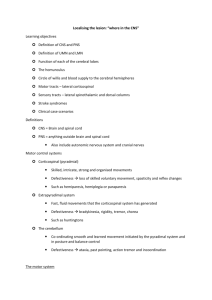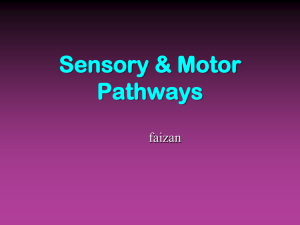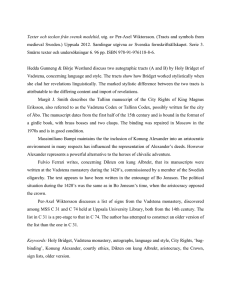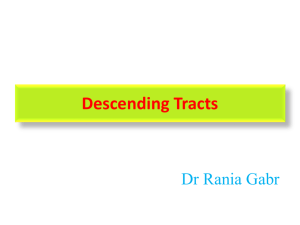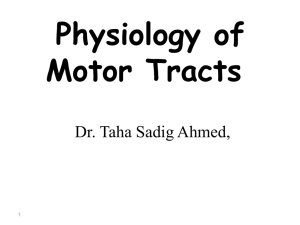Lectures Objectives & Outline Descending Tracts of Spinal Cord By
advertisement
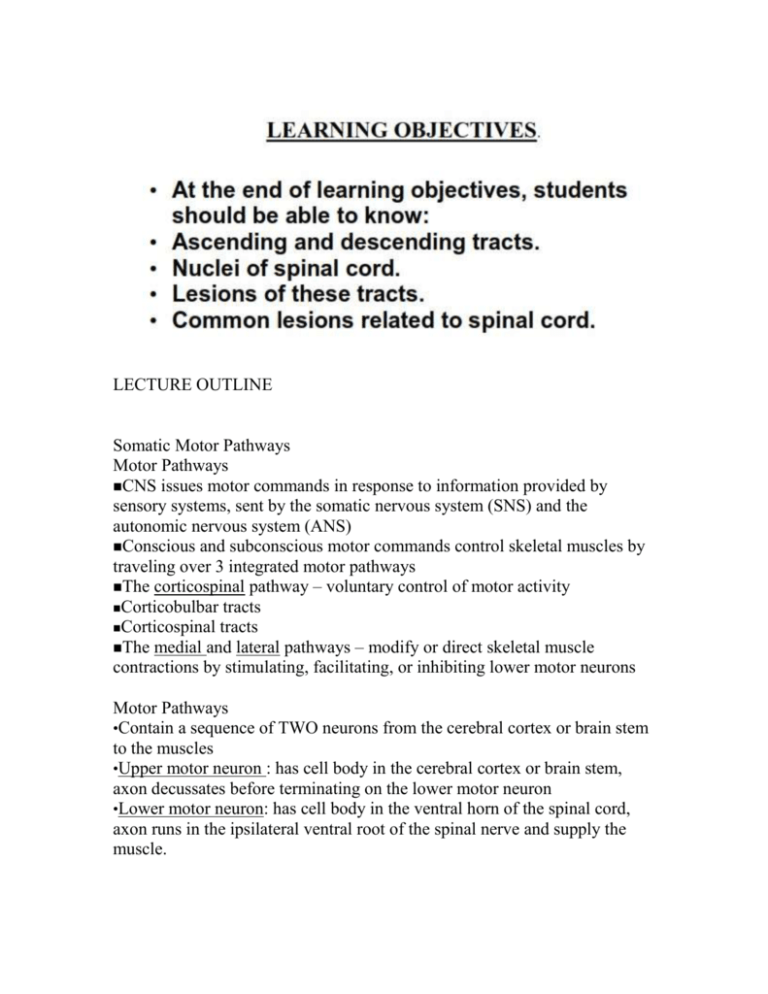
LECTURE OUTLINE Somatic Motor Pathways Motor Pathways CNS issues motor commands in response to information provided by sensory systems, sent by the somatic nervous system (SNS) and the autonomic nervous system (ANS) Conscious and subconscious motor commands control skeletal muscles by traveling over 3 integrated motor pathways The corticospinal pathway – voluntary control of motor activity Corticobulbar tracts Corticospinal tracts The medial and lateral pathways – modify or direct skeletal muscle contractions by stimulating, facilitating, or inhibiting lower motor neurons Motor Pathways •Contain a sequence of TWO neurons from the cerebral cortex or brain stem to the muscles •Upper motor neuron : has cell body in the cerebral cortex or brain stem, axon decussates before terminating on the lower motor neuron •Lower motor neuron: has cell body in the ventral horn of the spinal cord, axon runs in the ipsilateral ventral root of the spinal nerve and supply the muscle. COMPARISON BETWEEN UMN AND LMN Descending Spinal Tracts Originate from the cerebral cortex & brain stem Concerned with: Control of movements Muscle tone Spinal reflexes & equilibrium Modulation of sensory transmission to higher centers Spinal autonomic functions Direct (Pyramidal) System Regulates fast and fine (skilled) movements Originate in the pyramidal neurons in the precentral gyri, Impulses are sent through the corticospinal tracts and synapse in the anterior horn Stimulation of anterior horn neurons activates skeletal muscles Part of the direct pathway, called corticobulbar tracts, innervates cranial nerve nuclei Indirect (Extrapyramidal) System Complex and multisynaptic pathways The system includes: •Rubrospinal tracts: control flexor muscles •Vestibulospinal tracts: maintain balance and posture •Tectospinal tracts: mediate head neck, and eye movement •Reticulospinal tracts concerned with motor function Descending Spinal Tracts Corticospinal Tracts Concerned with voluntary, discrete skilled movements, especially those of distal parts of the limbs (fractionated movements) Innervate the contralateral side of the spinal cord Provide rapid direct method for controlling skeletal muscle Rubrospinal Tract Controls the tone of limb flexor muscles, being excitatory to motor neurons of these muscles Origin: Red nucleus Axons course ventro-medially, cross in ventral tegmental decussation, descend in spinal cord ventral to the lateral corticospinal tract Cortico-rubro-spinal pathway (Extrapyramidal) Tectospinal Tract Mediates reflex movements of the head and neck in response to visual stimuli Origin: Superior colliculus Axons course ventro-medially around the periaqueductal gray matter, cross in dorsal tegmental decussation, descend in spinal cord near the ventral median fissure, terminate mainly in cervical segments Cortico-tecto-spinal pathway (Extrapyramidal) Vestibulospinal Tracts Lateral Vestibulospinal Tracts Origin: lateral vestibular (Deiter’s) nucleus Axons descend ipsilaterally in the ventral funiculus Terminate on ventral horn cells throughout the length of spinal cord Has excitatory influences upon extensor motor neurons, control extensor muscle tone in the antigravity maintenance of posture Vestibulospinal Tracts Medial vestibulospinal tract Origin: medial vestibular nucleus Axons descend bilaterally in the ventral funiculus, with the medial longitudinal fasciculus Most of the fibers end in the cervical region, some reaching upper thoracic segments Involved in movements of the head required for maintaining equilibrium Reticulospinal Tracts Influence voluntary movement, reflex activity and muscle tone by controlling the activity of both alpha and gamma motor neurons Mediate pressor and depressor effect on the circulatory system Are involved in control of breathing Origin: pontine & medullary reticular formation Medial (pontine) reticulospinal tract descends ipsilaterally Lateral (medullary) reticulospinal tract descends bilaterally Both tracts located in the ventral funiculus Descending Autonomic Fibers The higher centers associated with the control of autonomic activity are situated mainly in the hypothalmaus The fibers run in the reticulospinal tracts Terminate on the autonomic neurons in the lateral horn of thoracic & upper lumbar (sympathetic) and sacral segments (parasympathetic) levels of the spinal cord
